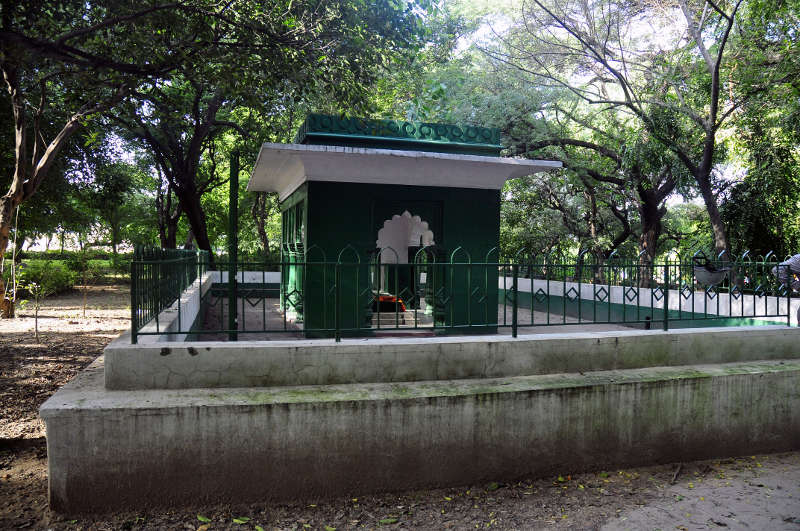FWP:
SETS == POETRY
SPRINGTIME: {13,2}
For background see S. R. Faruqi's choices. This verse is NOT one of Faruqi's choices, but I'm now adding it anyway because of its invocation of Bedil. For more on Ghalib's unpublished verses, see the discussion in {4,8x}.
The first line presents itself as a general statement: poetry is everywhere full of vitality and innovation, everywhere it has laid the foundation of a new, 'fresh' garden. Then the second line singles out Bedil for particular praise: he's the one who's responsible for creating this fresh springtime garden of style; the 'poetry' in the first line may well be his, but in any case is certainly indebted to him.
In a general way, this closing-verse surely alludes to tazah-go))ii , 'fresh-speaking', a Mughal-period style of Persian poetry associated with the work of Bedil and certain other Indo-Persian poets. It included a cult of the 'fresh word'. On this movement see 'Make it fresh: time, tradition, and Indo-Persian literary modernity' by Rajeev Kinra, in Time, History and the Religious Imaginary in South Asia, ed. by Anne Murphy (Routledge, 2011, pp. 12-39).
For more on this complex kind of metaphysical Persian poetry, see Paul E. Losensky, Welcoming Fighani: Imitation and Poetic Individuality in the Safavid-Mughal Ghazal (Costa Mesa, CA: Mazda Publishers, 1998). This poetic style or movement has in the past often been (inappropriately) called sabk-e hindii , 'Indian style'. This poetry has been said to feature 'metaphorical conceits, personification, proverbs, poetic etiology, unusual imagery, colloquialisms, tangled syntax, ellipses, and so forth' (p. 3). Later on, Losensky elaborates:
Most of these features, however, are direct consequences of an overriding concern for the startling and unexpected metaphor or turn of thought. Both inanimate objects and concepts are frequently personified, and concrete images often become elements of abstract thought. On the linguistic level, grammar and meter are pushed to their limits, and the sonority and niceties of poetic language are sometimes neglected. Under these circumstances, ambiguity ( iihaam ) can flourish on many levels, syntactical, referential, and metaphorical. Depending on the skill of the poet, such ambiguities can be a mere cause of confusion or a resource for exploring the full implications of a conceit. Whatever the case, the result of all these features is the brevity of language and density of poetic meaning known as iijaaz ['abridging, epitomizing']. Finally, poets of this school often turned to colloquial language as yet another source of novelty, disrupting the long-established poetic lexicon and stock of topoi with popular idioms, informal usages, and folksy aphorisms. By the standards of earlier periods, these are perhaps poetic lapses, brought about by ever more elaborate chains of poetic reasoning forced into the compass of a single verse; in the context of the fresh style, they appear as yet another manifestation of the new, another way of catching the reader's or listener's attention. (202-03)
To any serious reader of Ghalib, this all sounds entirely familiar. The present verse, like so many in the divan, is very early (1816). In the last few years of his life (c.1866) Ghalib wrote a letter that looked back, not very accurately, on this early 'metaphysical' poetry; for that letter and discussion of it, see {155,3}.
In particular, the present (unpublished) closing-verse pays a deep and sincere-seeming compliment to the great Indo-Persian poet Mirza Abd ul-Qadir 'Bedil' (1642-1720), whose convoluted, Persianized, i.zaafat -laden style the young Ghalib greatly admired. (Bedil has been called 'Ghalib's Ghalib'.) Among Ghalib's early Urdu verses were something like fifteen or sixteen tributes to Bedil; most of these, however, he did not include in his published divan (1841). Nor do there seem to be any such tributes to Bedil in his Persian ghazals (which were composed in the 1830's-40's). Mehr Farooqi has told me (Feb. 2019) that she thinks the reason Ghalib so markedly dethroned Bedil was simply that Bedil was Indian (he was born in Bihar), and in the aftermath of Ghalib's Calcutta controversies he committed himself firmly to the view that no Indian could be an authority on Persian poetry (except, quite explicitly, himself). He clearly continued to be influenced by Bedil, especially in Urdu, but around the time of his Calcutta trip he largely ceased to acknowledge the fact; on this see {100,9}.
Compare the unreceptive autumnal garden that fails to value Ghalib's 'fresh thought' [taazah-;xayaalii], in {154,6x}.
For other notable tributes to Bedil, see {12,7x}, in which Ghalib depicts Bedil as a Khizr-like guide; and {435x,8}, in which he imagines Bedil as a kind of Sufi pir into whose order he himself would be initiated. For a full list of such closing-verse tributes, see Bedil in the Names index.
Here is what is nowadays said (apparently on no evidence whatsoever) to be Bedil's tomb, in Delhi (photo courtesy of Sohail Hashmi, Feb. 2010):

Asi:
Oh Asad, his poetic craft has planted a verdant garden everywhere; the springtime-creating style of Bedil has pleased me. This ghazal too is probably from the time when Mirza Ghalib used to follow Bedil and Ali Sirhindi.
== Asi, p. 51